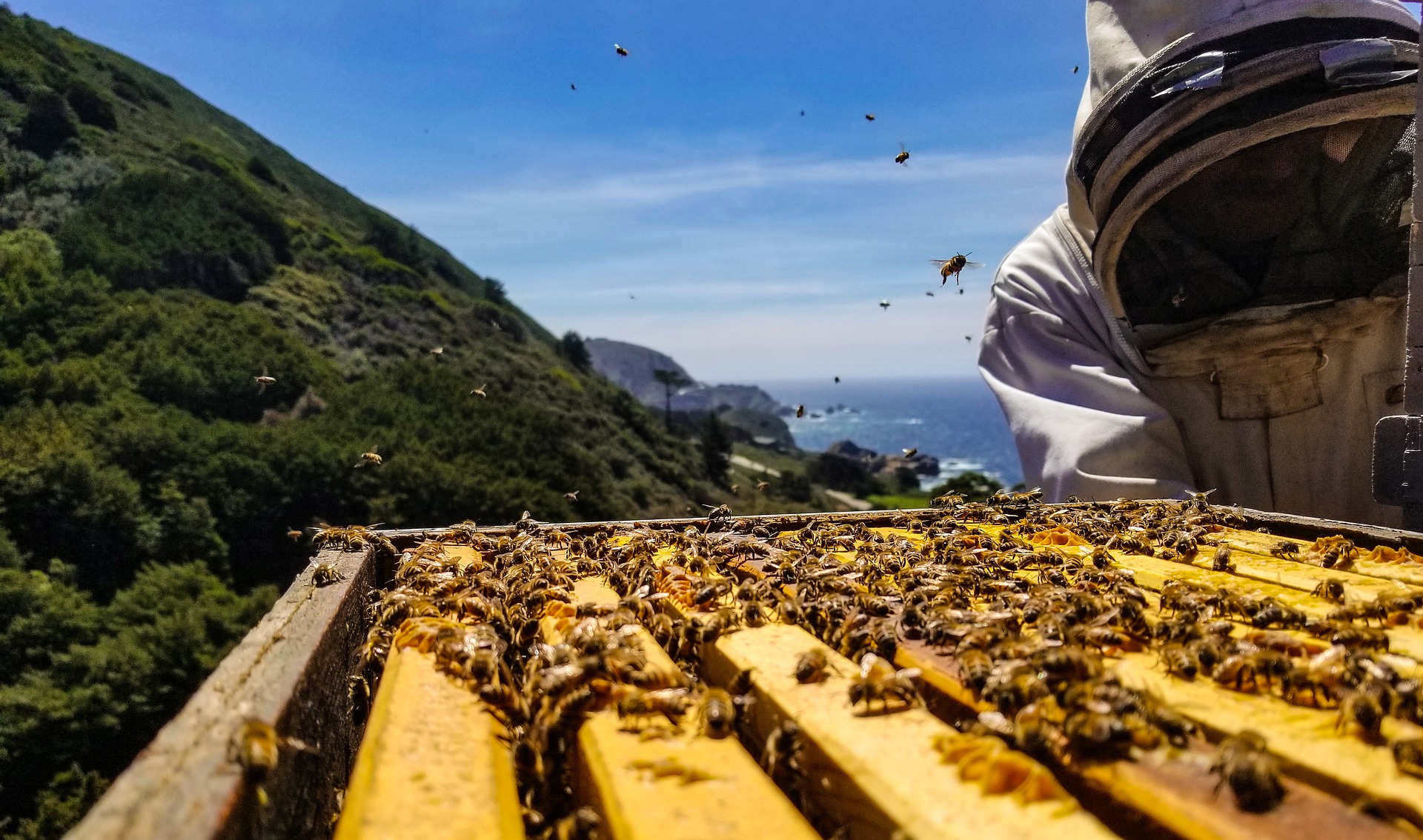In the first three articles on beekeeping, we gave you some background on why you should keep bees, what role bees play in pollination, and what goes on inside the hive. In this issue, we look at what you need to set up a bee colony.
Here are some things to do to get started:
- Inform yourself
- Find the best spot on your land
- Buy or make a hive
- Get a protective outfit
- Get the bees
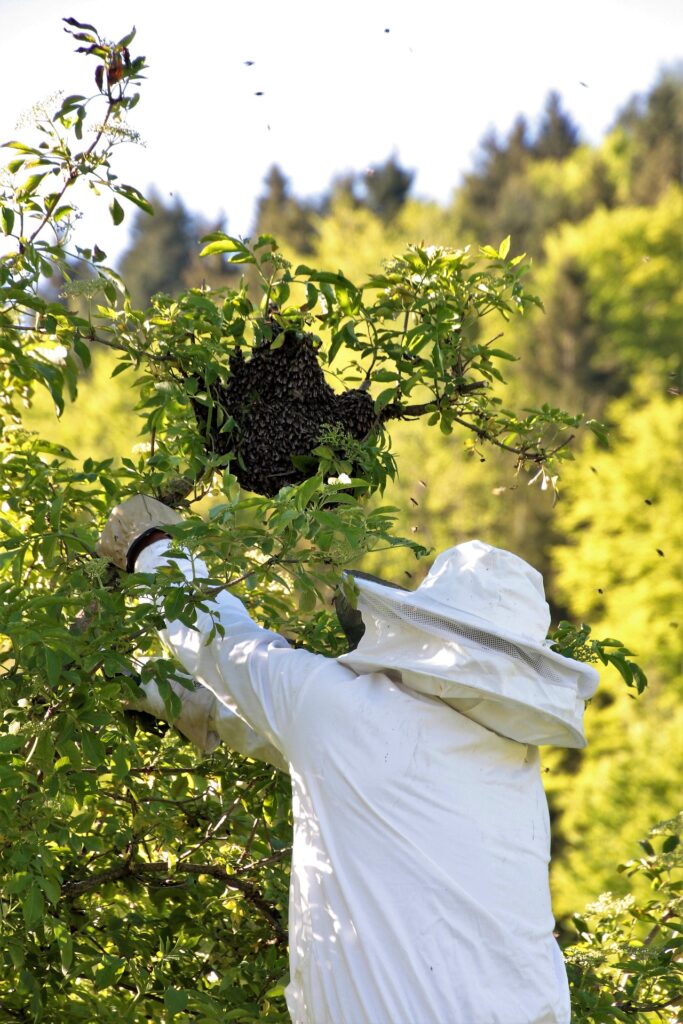
A beekeeper removes a swarm from a tree. (Source: Pixabay)
1. Inform yourself
It may seem difficult to start beekeeping. It is not that difficult, but it is best to be as well-informed as you can be. The best would be to visit an established beekeeper to find out more about what it’s about, but you can find much information on the internet via your cell phone. Remember that African bees are not the same as European bees, so make sure you get information on local bees!
Be warned, beekeeping is hard work, and it will keep you very busy all year round, especially in warmer areas. By finding out as much as you can before you start, you will avoid common mistakes beginner beekeepers make – but that’s also okay, because you learn best by experience.
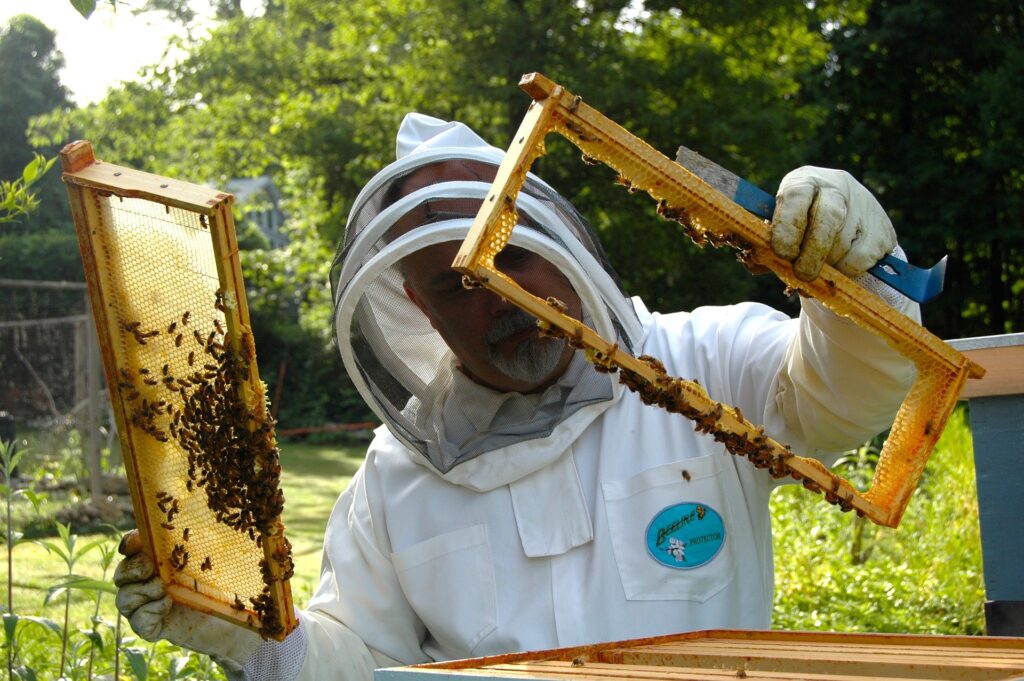
A beekeeper removing and cleaning a super from the hive. (Source: Pixabay)
2. Find the best spot on your land
There are several things to keep in mind when you decide where to put your group of hives, which is called an apiary.
Put it in a secluded spot where there is not too much movement. Constant activity will disturb the bees, and disturbed African bees can be very aggressive. Keep the apairy away from an area or path where people, and especially children, frequently go.
If you have a deciduous tree — one that loses its leaves in winter — you can place the apiary underneath it to provide shade from the hot afternoon sun. Bees work only when it is warm enough, but if it is too hot, they also don’t leave the hive because they must fan the inside to cool it down.
Place the entrance to the hive away from the direction of the wind, as strong wind will affect their flight.
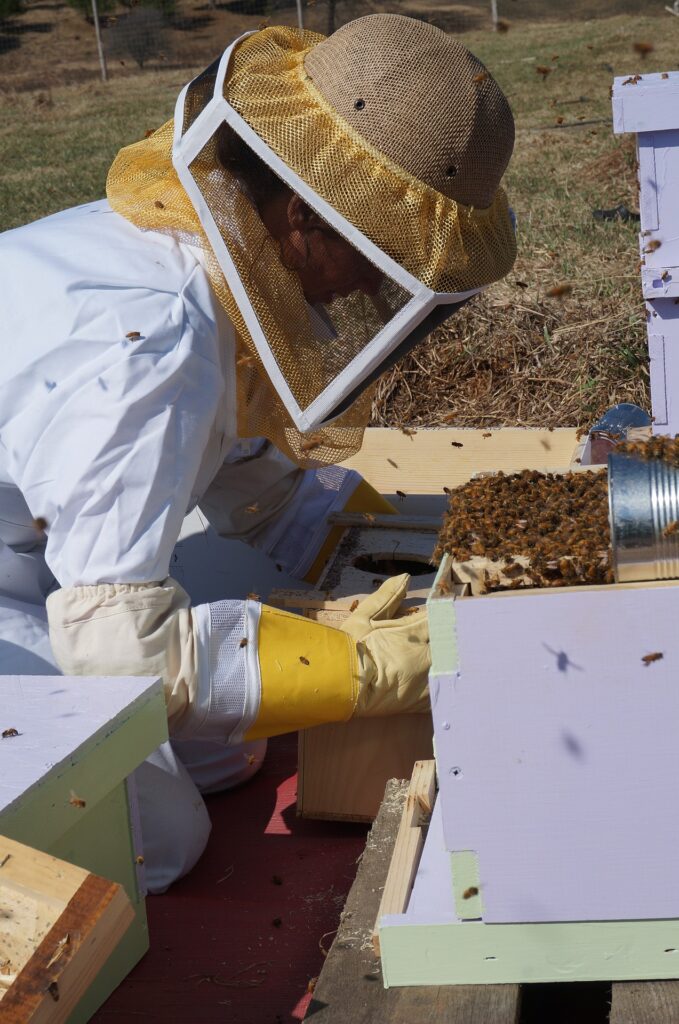
A beekeeper wearing a protective hat with a veil working with her bees. (Source: Pixabay)
If possible, it is good to put your apiary in an area that will not be wide open to thieves, whether the two- or four-legged ones! By putting the hive on a stand, you can deter honey-loving badgers from getting to it.
It is also important to put the apiary in or near an area where there is enough forage for nectar and pollen, like flowering wild trees, shrubs or wildflowers, fruit and nut trees and vegetables, as well as oil-producing and grain fields.
If you don’t have suitable forage, you can get permission from a landowner who has suitable and sustainable forage on his farm. To have bees on his land will also benefit him because of the free pollination service your bees will provide to help him grow a bigger crop.
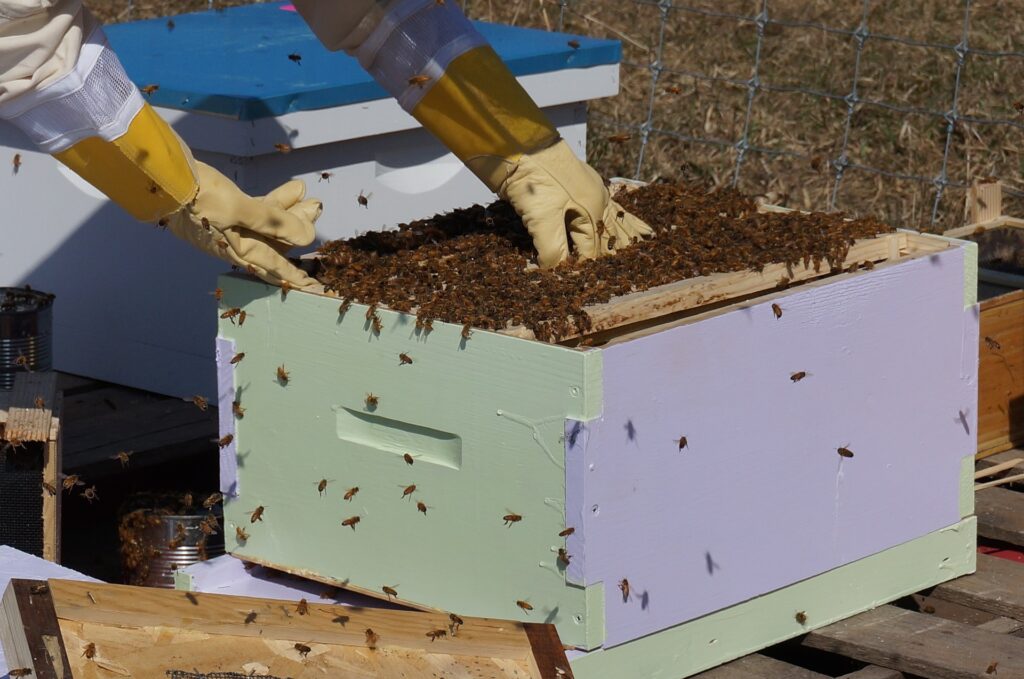
A beekeeper wearing protective gloves working with the bees on top of a hive. (Source: Pixabay)
Most importantly, it is essential that the bees have access to water, as bees need fresh, clean water to survive. A strong colony will need at least one litre of water on a warm day.
It is your responsibility to provide water to them, and it is best to set up a drinking pond before the bees arrive. If they must search for another water source, it may be difficult to redirect them to the water you provide. Put something that floats on the pool of water so that they will be able to drink water without falling in and drowning.
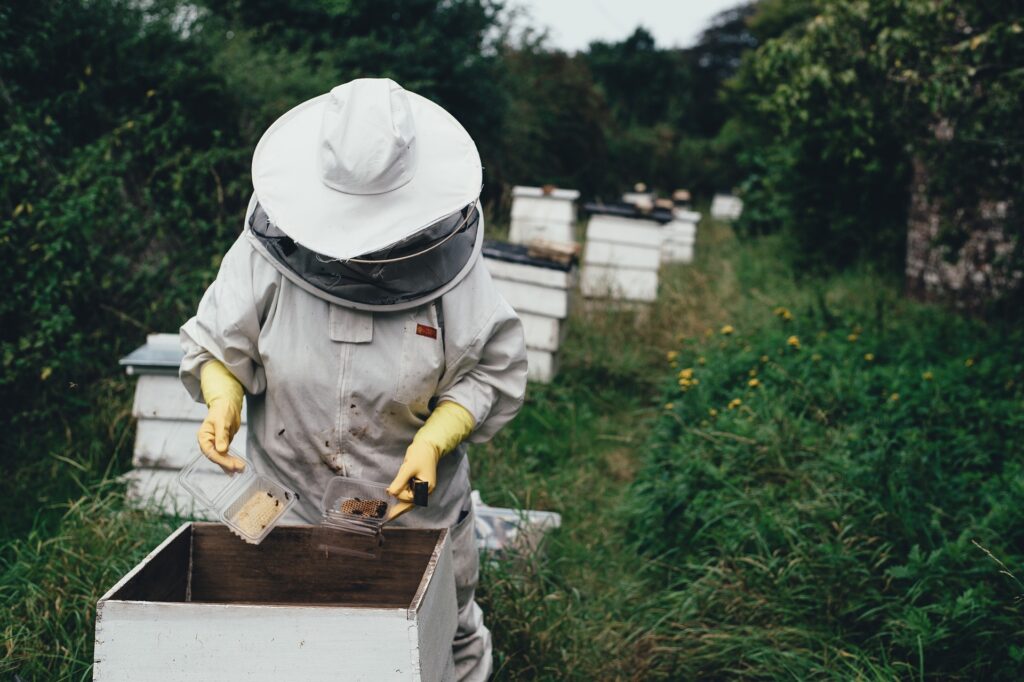
A woman in protective clothing working in her apiary. (Source: Pixabay)
3. Buy or build a hive
You can either buy or make a hive. You should start with no more than three hives. Once you have gained experience, you can get more.
It is best not to buy used hives, as these may carry viruses or diseases from the previous colonies. It is also wise to replace frames and foundations every three to five years to get rid of everything that may have contaminated the hive over time.
Hives are commercially available, but it may be costly to buy more than one. So why not buy one and copy it to make your own? If you have basic woodworking skills and tools, it won’t be too difficult.
The Langstroth hive is usually used in Africa. It can hold ten, or when the frames are fitted closer together, eleven frames.

Beekeepers inspecting bee activity on a super just removed from the hive. (Source: Pixabay)
The hive consists of a roof, three or more honey super boxes, a slide-out tray, crown board, queen excluder, brood box, and an open mesh floor.
The best wood to use include pine and bluegum, as well as kiaat.
Besides the hive, you also need a hive tool, a bee brush, a queen marking cage and pen, a medium-sized smoker, feeders for sugar syrup and pollen when times are tough for the bees, and a one-way porter bee escape that fits into the crown board for clearing the supers of bees.
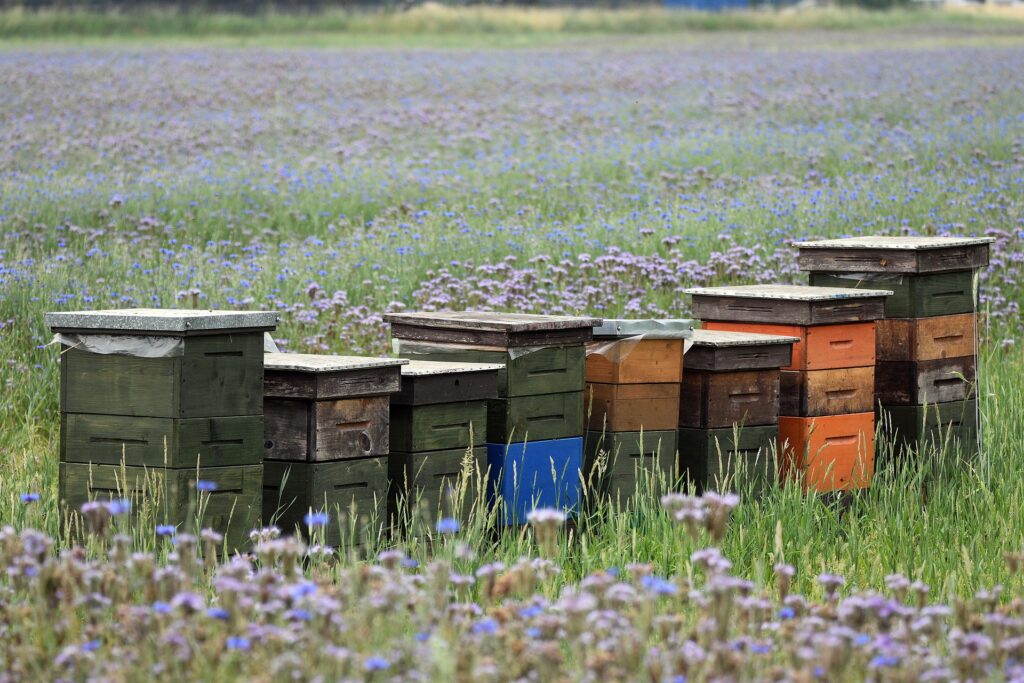
Hives in a flowering field that provides sufficient forage for the bees. (Source: Pixabay)
4. Protective clothing
It is important to dress for success. Protective white clothing that covers you from head to toe will protect you from painful stings.
The outfit consists of a cotton overall with long sleeves and pants, a hat with a veil that fastens to the top of the overall, thick gloves that fit tightly around the arm, and boots that fit tightly around the ankles. There must be no gap that allows a bee to crawl inside the suit.
Suits are commercially available and cost on average R1 600 (K1 900), when ordered from South Africa, but a ventilated suit that will be cooler to wear, costs at least double that amount.
5. Get the bees
The best way to find your first swarm of bees is to get it from an established beekeeper, who will provide you with a swarm or even half a swarm of bees, including a queen. The bees will be in a container and the queen will come in a cage.
To release your swarm, you put the queen on top of the hive. Release the bees into the hive by shaking the container to empty the bees into it. You should wear your protective clothing and mask, but usually the bees are so concerned with finding their new home that they shouldn’t take much notice of you. When done, release the queen from her cage in the fourth frame.
In the next issue, we shall provide more information on building a hive.
References
Anderson, R.H., Buys, B., Johannsmeier, M.F. (2014) Byeboerdery in Suid-Afrika. Hersiene uitgawe. Departement van Landbou-tegniese dienste Bulletin no. 394, 1978.
Katy. (2019). How to set up a bee colony: Beekeeping 101. Beekeeping Basics. www.beekeepingbasic.com/how-to-set-up-a-bee-colony-beekeeping-101/
Katy. (2019). Become a successful beekeeper by following these 10 tips. Beekeeping for beginners. www.beekeepingbasic.com/BECOME-ASUCCESSFUL-BEEKEEPER-BY-FOLLOWING-THESE-10-TIPS/
Katy. (2019). Here’s why you should start beekeeping. Beekeeping for Beginners. www.beekeepingbasic.com/heres-why-you-should-startbeekeeping

